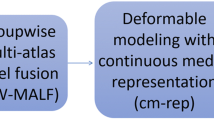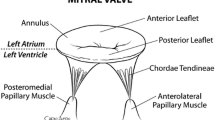Abstract
Several new techniques to repair the mitral valve affected by functional mitral regurgitation are in development. However, due to the heterogeneity of valve lesions between patients, predicting the outcomes of novel treatment approaches is challenging. We present a patient-specific, 3D ultrasound-derived computational model of the mitral valve for procedure planning, that faithfully mimics the pathological valve dynamics. 3D ultrasound images were obtained in three pigs induced with heart failure and which developed functional mitral regurgitation. For each case, images were segmented, and finite element model of mitral valve was constructed. Annular and papillary muscle dynamics were extracted and imposed as kinematic boundary conditions, and the chordae were pre-strained to induce valve tethering. Valve closure was simulated by applying physiologic transvalvular pressure on the leaflets. Agreement between simulation results and truth datasets was confirmed, with accurate location of regurgitation jets and coaptation defects. Inclusion of kinematic patient-specific boundary conditions was necessary to achieve these results, whereas use of idealized boundary conditions deviated from the truth dataset. Due to the impact of boundary conditions on the model, the effect of repair strategies on valve closure varied as well, indicating that our approach of using patient-specific boundary conditions for mitral valve modeling is valid.





Similar content being viewed by others
References
Chandran, K. B., and H. Kim. Computational mitral valve evaluation and potential clinical applications. Ann. Biomed. Eng. 43(6):1348–1362, 2015.
Choi, A., Y. Rim, J. S. Mun, and H. Kim. A novel finite element-based patient-specific mitral valve repair: virtual ring annuloplasty. Biomed. Mater. Eng. 24(1):341–347, 2014.
Cochran, R. P., K. S. Kunzelman, C. J. Chuong, M. S. Sacks, and R. C. Eberhart. Nondestructive analysis of mitral valve collagen fiber orientation. ASAIO Trans. 37(3):M447–M448, 1991.
Drach, A., A. H. Khalighi, and M. S. Sacks. A comprehensive pipeline for multi-resolution modeling of the mitral valve: validation, computational efficiency, and predictive capability. Int. J. Numer. Method. Biomed. Eng. 34(2):e2921, 2018.
Jensen, H., M. O. Jensen, M. H. Smerup, S. Ringgaard, T. S. Sorensen, N. T. Andersen, P. Wierup, J. M. Hasenkam, and S. L. Nielsen. Three-dimensional assessment of papillary muscle displacement in a porcine model of ischemic mitral regurgitation. J. Thorac. Cardiovasc. Surg. 140(6):1312–1318, 2010.
Jimenez, J. H., D. D. Soerensen, Z. He, J. Ritchie, and A. P. Yoganathan. Effects of papillary muscle position on chordal force distribution: an in-vitro study. J. Heart Valve Dis. 14(3):295–302, 2005.
Kalra, K., Q. Wang, B. V. McIver, W. Shi, R. A. Guyton, W. Sun, E. L. Sarin, V. H. Thourani, and M. Padala. Temporal changes in interpapillary muscle dynamics as an active indicator of mitral valve and left ventricular interaction in ischemic mitral regurgitation. J. Am. Coll. Cardiol. 64(18):1867–1879, 2014.
Kim, J. H., E. Y. Kim, G. Y. Jin, and J. B. Choi. A review of the use of cardiac computed tomography for evaluating the mitral valve before and after mitral valve repair. Korean J. Radiol. 18(5):773–785, 2017.
Kong, F., T. Pham, C. Martin, J. Elefteriades, R. McKay, C. Primiano, and W. Sun. Finite element analysis of annuloplasty and papillary muscle relocation on a patient-specific mitral regurgitation model. PLoS ONE. 13(6):e0198331, 2018.
Kunzelman, K. S., D. R. Einstein, and R. P. Cochran. Fluid-structure interaction models of the mitral valve: function in normal and pathological states. Philos. Trans. R. Soc. B. 362(1484):1393–1406, 2007.
Kwan, J., T. Shiota, D. A. Agler, Z. B. Popovic, J. X. Qin, M. A. Gillinov, W. J. Stewart, D. M. Cosgrove, P. M. McCarthy, and J. D. Thomas. Geometric differences of the mitral apparatus between ischemic and dilated cardiomyopathy with significant mitral regurgitation: real-time three-dimensional echocardiography study. Circulation. 107(8):1135–1140, 2003.
Lee, C. H., R. Amini, R. C. Gorman, J. H. Gorman 3rd., and M. S. Sacks. An inverse modeling approach for stress estimation in mitral valve anterior leaflet valvuloplasty for in-vivo valvular biomaterial assessment. J. Biomech. 47(9):2055–2063, 2014.
Li, B., Y. Cui, D. Zhang, X. Luo, F. Luo, B. Li, and Y. Tang. The characteristics of a porcine mitral regurgitation model. Exp. Anim. 67(4):463–477, 2018.
Mahmood, F., Z. O. Knio, L. Yeh, R. Amir, R. Matyal, A. Mashari, R. C. Gorman, J. H. Gorman 3rd., and K. R. Khabbaz. Regional heterogeneity in the mitral valve apparatus in patients with ischemic mitral regurgitation. Ann. Thorac. Surg. 103(4):1171–1177, 2017.
Mangieri, A., A. Laricchia, F. Giannini, F. Gallo, F. Kargoli, A. Ladanyi, L. Testa, A. Colombo, and A. Latib. Emerging technologies for percutaneous mitral valve repair. Front. Cardiovasc. Med. 6:161, 2019.
May-Newman, K., and F. C. Yin. A constitutive law for mitral valve tissue. J. Biomech. Eng. 120(1):38–47, 1998.
Milani-Nejad, N., and P. M. Janssen. Small and large animal models in cardiac contraction research: advantages and disadvantages. Pharmacol. Ther. 141(3):235–249, 2014.
Oliveira, D., J. Srinivasan, D. Espino, K. Buchan, D. Dawson, and D. Shepherd. Geometric description for the anatomy of the mitral valve: a review. J. Anat. 237(2):209–224, 2020.
Onohara, D., K. S. Suresh, M. Silverman, Q. He, T. Kono, and M. Padala. Image-guided targeted mitral valve tethering with chordal encircling snares as a preclinical model of secondary mitral regurgitation. J. Cardiovasc. Transl. Res. 2021. https://doi.org/10.1007/s12265-021-10177-x.
Ooms, J. F., D. D. Wang, R. Rajani, S. Redwood, S. H. Little, M. L. Chuang, J. J. Popma, G. Dahle, M. Pfeiffer, B. Kanda, M. Minet, A. Hirsch, R. P. Budde, P. P. De Jaegere, B. Prendergast, W. O’Neill, and N. M. Van Mieghem. Computed tomography-derived 3D modeling to guide sizing and planning of transcatheter mitral valve interventions. JACC Cardiovasc. Imaging. 14(8):1644–1658, 2021.
Park, M. H., Y. Zhu, A. M. Imbrie-Moore, H. Wang, M. Marin-Cuartas, M. J. Paulsen, and Y. J. Woo. Heart valve biomechanics: the frontiers of modeling modalities and the expansive capabilities of ex vivo heart simulation. Front. Cardiovasc. Med. 8:673689, 2021.
Pham, T., F. Kong, C. Martin, Q. Wang, C. Primiano, R. McKay, J. Elefteriades, and W. Sun. Finite element analysis of patient-specific mitral valve with mitral regurgitation. Cardiovasc. Eng. Technol. 8(1):3–16, 2017.
Pokutta-Paskaleva, A., F. Sulejmani, M. DelRocini, and W. Sun. Comparative mechanical, morphological, and microstructural characterization of porcine mitral and tricuspid leaflets and chordae tendineae. Acta Biomater. 85:241–252, 2019.
Prot, V., B. Skallerud, G. Sommer, and G. A. Holzapfel. On modelling and analysis of healthy and pathological human mitral valves: two case studies. J. Mech. Behav. Biomed. Mater. 3(2):167–177, 2010.
Rego, B. V., A. H. Khalighi, A. Drach, E. K. Lai, A. M. Pouch, R. C. Gorman, J. H. Gorman 3rd., and M. S. Sacks. A noninvasive method for the determination of in vivo mitral valve leaflet strains. Int. J. Numer. Method. Biomed. Eng. 34(12):e3142, 2018.
Rim, Y., D. D. McPherson, and H. Kim. Effect of leaflet-to-chordae contact interaction on computational mitral valve evaluation. Biomed. Eng. Online. 13(1):31, 2014.
Ritchie, J., J. N. Warnock, and A. P. Yoganathan. Structural characterization of the chordae tendineae in native porcine mitral valves. Ann. Thorac. Surg. 80(1):189–197, 2005.
Sacks, M., A. Drach, C. H. Lee, A. Khalighi, B. Rego, W. Zhang, S. Ayoub, A. Yoganathan, R. C. Gorman, and J. H. Gorman 3rd. On the simulation of mitral valve function in health, disease, and treatment. J. Biomech. Eng. 141(7):0708041–07080422, 2019.
Sengupta, A., S. L. Alexis, S. Zaid, G. H. L. Tang, S. Lerakis, and R. P. Martin. Imaging the mitral valve: a primer for the interventional surgeon. Ann. Cardiothorac. Surg. 10(1):28–42, 2021.
Sielicka, A., E. L. Sarin, W. Shi, F. Sulejmani, D. Corporan, K. Kalra, V. H. Thourani, W. Sun, R. A. Guyton, and M. Padala. Pathological remodeling of mitral valve leaflets from unphysiologic leaflet mechanics after undersized mitral annuloplasty to repair ischemic mitral regurgitation. J. Am. Heart Assoc. 7(21):e009777, 2018.
Stevanella, M., F. Maffessanti, C. A. Conti, E. Votta, A. Arnoldi, M. Lombardi, O. Parodi, E. G. Caiani, and A. Redaelli. Mitral valve patient-specific finite element modeling from cardiac MRI: application to an annuloplasty procedure. Cardiovasc. Eng. Technol. 2(2):66–76, 2011.
Sturla, F., F. Onorati, E. Votta, K. Pechlivanidis, M. Stevanella, A. D. Milano, G. Puppini, A. Mazzucco, A. Redaelli, and G. Faggian. Is it possible to assess the best mitral valve repair in the individual patient? Preliminary results of a finite element study from magnetic resonance imaging data. J. Thorac. Cardiovasc. Surg. 148(3):1025–1034, 2014.
Sturla, F., A. Redaelli, G. Puppini, F. Onorati, G. Faggian, and E. Votta. Functional and biomechanical effects of the edge-to-edge repair in the setting of mitral regurgitation: consolidated knowledge and novel tools to gain insight into its percutaneous implementation. Cardiovasc. Eng. Technol. 6(2):117–140, 2015.
Tsang, H. G., N. A. Rashdan, C. B. Whitelaw, B. M. Corcoran, K. M. Summers, and V. E. MacRae. Large animal models of cardiovascular disease. Cell Biochem. Funct. 34(3):113–132, 2016.
Uno, G., T. Omori, S. Shimada, F. Rader, R. J. Siegel, and T. Shiota. Differences in mitral valve geometry between atrial and ventricular functional mitral regurgitation in patients with atrial fibrillation: a 3D transoesophageal echocardiography study. Eur. Heart J. Cardiovasc. Imaging. 22(10):1106–1116, 2021.
Votta, E., E. Caiani, F. Veronesi, M. Soncini, F. M. Montevecchi, and A. Redaelli. Mitral valve finite-element modelling from ultrasound data: a pilot study for a new approach to understand mitral function and clinical scenarios. Philos. Trans. R. Soc. A. 366(1879):3411–3434, 2008.
Walther, C., S. Fichtlscherer, T. Holubec, M. Vasa-Nicotera, M. Arsalan, and T. Walther. New developments in transcatheter therapy of mitral valve disease. J. Thorac. Dis. 12(4):1728–1739, 2020.
Xu, C., A. S. Jassar, D. P. Nathan, T. J. Eperjesi, C. J. Brinster, M. M. Levack, M. Vergnat, R. C. Gorman, J. H. Gorman 3rd., and B. M. Jackson. Augmented mitral valve leaflet area decreases leaflet stress: a finite element simulation. Ann. Thorac. Surg. 93(4):1141–1145, 2012.
Yamauchi, H., E. N. Feins, N. V. Vasilyev, S. Shimada, D. Zurakowski, and P. J. Del Nido. Creation of nonischemic functional mitral regurgitation by annular dilatation and nonplanar modification in a chronic in vivo swine model. Circulation. 128(11):S263–S270, 2013.
Zhan-Moodie, S., D. Xu, K. S. Suresh, Q. He, D. Onohara, K. Kalra, R. A. Guyton, E. L. Sarin, and M. Padala. Papillary muscle approximation reduces systolic tethering forces and improves mitral valve closure in the repair of functional mitral regurgitation. JTCVS Open. 7:91–104, 2021.
Acknowledgments
This work was funded by the National Heart, Lung and Blood Institute through Grants HL133667, HL135145, and HL140325, an American Heart Association Grant #834086, and an infrastructure grant from the Carlyle Fraser Heart Center to M.P. Some parts of the mitral valve modeling approach presented in this study were developed based on the code created by Biomechanics Group at DEIB, Politecnico di Milano (Italy). We would like to acknowledge their effort and thank them for sharing the code.
Conflict of interest
M.P. and K.S.S. disclose equity interest in Nyra Medical Inc. M.P. receives consulting fees from Heart Repair Technologies Inc. None of these entities funded or reviewed this work. G.G. and D.X. has no financial relationships to disclose.
Author information
Authors and Affiliations
Corresponding author
Additional information
Associate Editor Ender A. Finol oversaw the review of this article.
Publisher's Note
Springer Nature remains neutral with regard to jurisdictional claims in published maps and institutional affiliations.
Rights and permissions
About this article
Cite this article
Gaidulis, G., Suresh, K.S., Xu, D. et al. Patient-Specific Three-Dimensional Ultrasound Derived Computational Modeling of the Mitral Valve. Ann Biomed Eng 50, 847–859 (2022). https://doi.org/10.1007/s10439-022-02960-x
Received:
Accepted:
Published:
Issue Date:
DOI: https://doi.org/10.1007/s10439-022-02960-x




